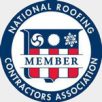You may have extensive leaking that repairs aren’t fixing. You have a wood roof and your home owners insurance is threatening to drop coverage. You see ceiling spots, algae growth, missing shingles, blistering, curling, buckling, missing granules damaged flashing, or rotting.
Even if your roof shows signs of these symptoms mentioned above, you may not need a total roof replacement. Call us for a Free Roof Inspection and if needed, a Free Estimate.
Not necessarily. Leaking can result because some flashings have come loose or because a section of the roof has been damaged. A roof failure, however, is generally irreversible and results from improper installation, poor quality materials, or from the installation of a roof system inappropriate to the building.
Most work should not be do-it-yourself. Professional roofing contractors are trained to safely and efficiently repair or replace a roof. Novices can harm a roof with improper roofing techniques and severely injure themselves by falling off, or even through, a roof in need of repair or replacement. Homeowner maintenance should be confined to roof inspections in both the fall and spring to check for cracked or curling shingles, and to cleaning rain gutters filled with dead leaves and other debris. If you must see the roof for yourself, use a firmly braced or tied-off ladder equipped with rubber safety feet. Wear rubber-soled shoes and stay on the ladder (and off the roof) if possible.
Yes! Although you may save a few dollars in re-roofing over your existing roof you are potentially covering over problem areas that need to be properly addressed. Also, you increase your chances of your new roof experiencing problems. There is also a weight issue depending on type of roof and how many layers you have. Often times you can tell that a roof wasn’t removed by the waves it causes under the new roof.
- Good ventilation creates a cooler attic in the summer
- An overheated attic, combined with moisture, can be damaging to roof sheathing and roof shingles, causing them to age and deteriorate prematurelyGood ventilation creates a drier attic in the winter and helps prevent ice dams
- Good ventilation serves two main functions:
- Moves hot air next to the roof deck out of the attic in the summer
- Dilutes and removes the moist air in the winter before it can cause damage
Smith’s Roofing uses a high quality synthetic underlayment as a standard on all of our roofs. It is better in every way than 15# felt and even 30# felt. Many companies will try to “up sell” you on this.
The average home getting a composition asphalt roof takes 4 Days. A tile home takes up to a week.
Day One: Remove existing roof. If needed re-sheet home and nail off. Wood repair if needed. Clean up.
Day Two: City or County Inspector arrives to inspect work thus far. Roofing material gets loaded onto roof.
Day Three: New roof gets installed. Clean up.
Day Four: City or County inspector returns for final roofing inspection.

Red Flag Warnings
Wrong. If your roofer is unlicensed then that means that he doesn’t carry workers compensation insurance for his employees. If one of them gets injured on the job then it is YOU, the home owner, that is responsible for the medical bills, etc. Smith’s roofing is licensed and carries workers compensation insurance for all of its employees.
Yes it does! Many contractors do not carry General Liability Insurance. This insurance covers any damages that may occur to your property just as workers compensation insurance covers the employees. Smith’s Roofing has a million dollar liability policy to ensure that you, your home and your property are fully protected.
Do not do this! It is your contractor’s job to pull the permit and schedule inspections. The only reason some one would have you, the home owner, pull the permit is if he/she did not have a license. You can check on a contractor’s license by contacting the Contractors State License Board at (800) 321-CSLB (2752) or visit the CSLB Web site at www.cslb.ca.gov.
Yes! A contractor is only allowed by law to receive a down payment of 10 percent or $1000, whichever is less. An established roofer will not need to collect money upfront for materials. By doing this you are opening yourself up to possibly being scammed. Progress payments should be outlined in your contract with the largest amount waiting until the job is finished to your complete satisfaction and is the final inspection is signed by the inspector.
No! This is called an open ended contract, a tactic used by many contractors. Once they start the job, they then ask for more money for “unforseeable” problems such as fascia rot, rotted sheathing, or in the case of tile, rafter reinforcement. An experienced roofer can foresee all of these and address them in his/her initial bid. With Smith’s Roofing, the price we quote you is the price you pay!











